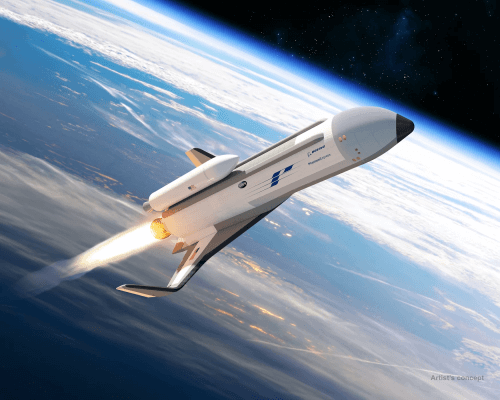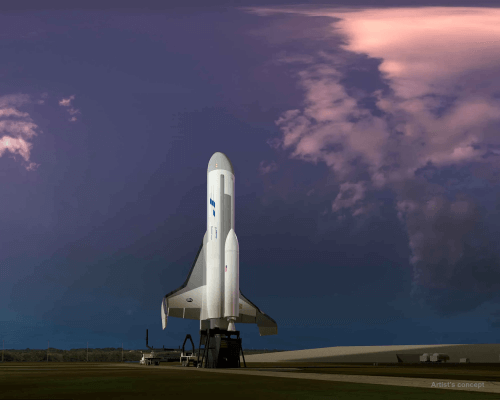DARPA, the research agency of the US Department of Defense, chose Boeing to develop the XS-1 (which Boeing calls the "Phantom Express"), a space plane that can take off again within hours of landing. The plane will first function like a normal rocket that is launched vertically, and then release a small upper rocket stage, which will bring the payload into orbit around the Earth, while it itself will land on the ground at Dayah.

The Military Agency for Advanced Research Projects (DARPA) announced yesterday that it had chosen Boeing to develop for it the XS-1 space plane (short for Experimental Spaceplane), which is designed to launch small satellites into orbit around the Earth. the plane Referred to by Boeing under the name "Phantom Express".
The experimental launch system will be autonomous and will consist of two stages: the central stage will be the plane itself, which will function like a regular rocket and be launched vertically to supersonic speed. The plane will release a single-use upper rocket stage from its back, which will place the payload in orbit around the Earth. The plane itself will not enter orbit, but will only reach the limit of space (ie: a sub-orbital height of up to 100 km). After releasing the upper stage, it will return to Israel, and use its wings to land on a runway.
According to DARPA, the space plane will be similar in size to a private executive plane. It will be able to launch a relatively light payload, of up to 1,360 kg, and bring it to a polar orbit around the Earth (an orbit that goes from pole to pole, and due to the self-rotation of the Earth allows for global observation).
The rocket engine of the plane will be provided by Aerojet Rocketdyne, and will be based on The main engine of the space shuttles. Unlike the shuttles, which used side boosters and a huge fuel tank to reach space, the new plane will be completely independent, using only its internal fuel tanks.
A unique feature of the plane will be its ability to take off very quickly and without the need for a wait that lasts months and sometimes even years. One of DARPA's demands from Boeing was that the plane should be able to take off 10 times in 10 days. According to the military agency, this capability will preserve the security of the United States, in the event of an emergency of loss or destruction of the country's commercial or military satellites, which in the modern age constitute an invaluable infrastructure.
Another goal of the project is to significantly lower the costs of launching into space. Similar to the SpaceX company that is developing the Falcon 9 multi-purpose launcher, the XS-1 will also be multi-purpose (although it should be noted that both the Falcon 9 and the new aircraft will not be completely multi-purpose - both have a disposable upper rocket stage).
DARPA predicts that if the development of the space plane goes through successfully, the cost of its launch, together with the single-use upper stage, will be only about 5 million dollars (although this is not the final commercial price).
"The XS-1 will not be a traditional aircraft nor a conventional launch vehicle, but a combination of the two, with the goal of reducing launch costs to a tenth [of today's price] and replacing the long and frustrating wait today for launch on demand," said Jess Sponbel, Project manager at Darfa. "We are very proud of Boeing's progress on the XS-1 during Phase 1 of the program, and look forward to continuing our close collaboration in Phases 2 and 3, which have now been approved for financing - production and flight."
DARPA's announcement of Boeing as the aircraft supplier brings to an end a competition that began in 2013, when the military agency announced its intention to develop the multi-purpose aircraft. Boeing beat out two competing bids from space companies Northrop Grumman and Masten Space Systems.
This is not the only cooperation of Boeing with the US Ministry of Defense, within which DARPA operates, in the field of space: the company built two models of the mysterious X-37B space plane for the US Air Force. Recently He returned to Israel from his fourth mission, after 718 days of being in space.

For DARPA, this is not its first attempt to develop a reusable space launcher. The agency tried several times in the past to develop such vehicles, but technological and budgetary difficulties prevented it from achieving its goal. Only recently, in 2015, the agency Canceled A program within which attempted to convert an F-15 into a small space launcher by mounting a small rocket on its belly. The program was canceled due to fear for the lives of the pilots, but DARPA said that some of the autonomous flight systems developed in it will be integrated into the new plane.
Boeing and DARPA will now begin the second phase of the XS-1 program, which will include building a prototype and ground tests in 2019, during which the engine will be fired 10 times in 10 days. The third phase of the project will begin in 2020, during which test flights will be carried out that will test the vehicle's rapid launch capability, by launching it 10 times within 10 days. The initial flights will bring it to speeds of Mach 5. In more advanced launches, the plane will reach a speed of up to Mach 10, in which it will be able to launch into orbit a cargo weighing 400 to 1,360 kg.
To help the private sector develop innovative launch systems with a fast launch rate, the agency announced that it will publish some of the results of the experiments that will be carried out on the space plane.
"We are pleased to see that this capability, which is truly futuristic, is moving closer to being realized," said Brad Tousley, director of DARPA's Tactical Technology Office, which is responsible for the XS-1 program. "The demonstration of routine access to space, on demand, using an aircraft-like vehicle, is important to achieving the critical needs of the Ministry of Defense, and can help open the door for a new generation of commercial opportunities."

5 תגובות
to June
The vector steering surfaces in SpaceX, which are responsible for the return, are much more problematic
For control (and faster wear) from the aerodynamic surfaces that return the XS-1,
Therefore, the need to check and replace them after each mission probably arose.
It is also possible that the engine design of the XS-1 takes into account less operating time and pressures
Smaller than those of the Spice X to allow for faster relaunch.
No.
What caused the shuttle accidents were seals that froze and did not seal in the solid boosters (Challenger)
and the coating of the external fuel tank that fell and damaged the thermal insulation of the shuttle (Columbia)
The XS-1 does not have an external fuel tank with plastic insulation and no solid boosters (at least
At the moment, it is possible that they will add later..) Therefore there is no reason for your concerns.
D.
I didn't see windshields on the XS-1, so I think it's a UAV
(and not a "space plane" or a shuttle) that at most will go the way of any missile...
It is possible to build a fleet of military satellites (espionage, communication, navigation...)
small and with a short life span. and launch them at short notice only in times of war or tensions or in the event of damage to the fixed satellites.
It is known that China is working hard on anti-satellite weapons and it is not the only one.
The US relies heavily on its satellites during wartime (for example, a large part of GPS-based guided weapons will become useless if enough satellites are hit.) Therefore, this is very threatening to the US. Such a launcher can neutralize the threat if the US can launch a replacement satellite within a few hours (even if only temporary and with partial capabilities compared to the large satellites) and all this at a relatively small cost and with the help of a few launchers
יוני
These are very different solutions even if they are trying to solve the same problem.
Which solution is better?
To know you must try to develop both. And it may turn out that each of the solutions has its own advantages. Or that each of them is more effective in different weights.
If I understand correctly the biggest advantage of this invention is the short time it takes to prepare the launcher for a new mission. It is especially important for military missions (the project is financed by the Ministry of Defense) I don't think that the Spice X launcher has a chance for 10 launches in 10 days.
It is not clear to me - why build a solution that is quite similar to the solution that exists today for the reusable launcher that automatically returns to the landing site, of the Space X company
It's more of a multi-launch missile with wings for maintenance.
The decision to place the charge with the belly and not at the top of the missile is strange to me. This has many disadvantages such as high air contention at takeoff and risk of malfunctions like the Columbia shuttle had.
I guess the advantage is greater simplicity in disconnection.
By and large, the whole story sounds simpler and more logical than a solution of returning the missile vertically.